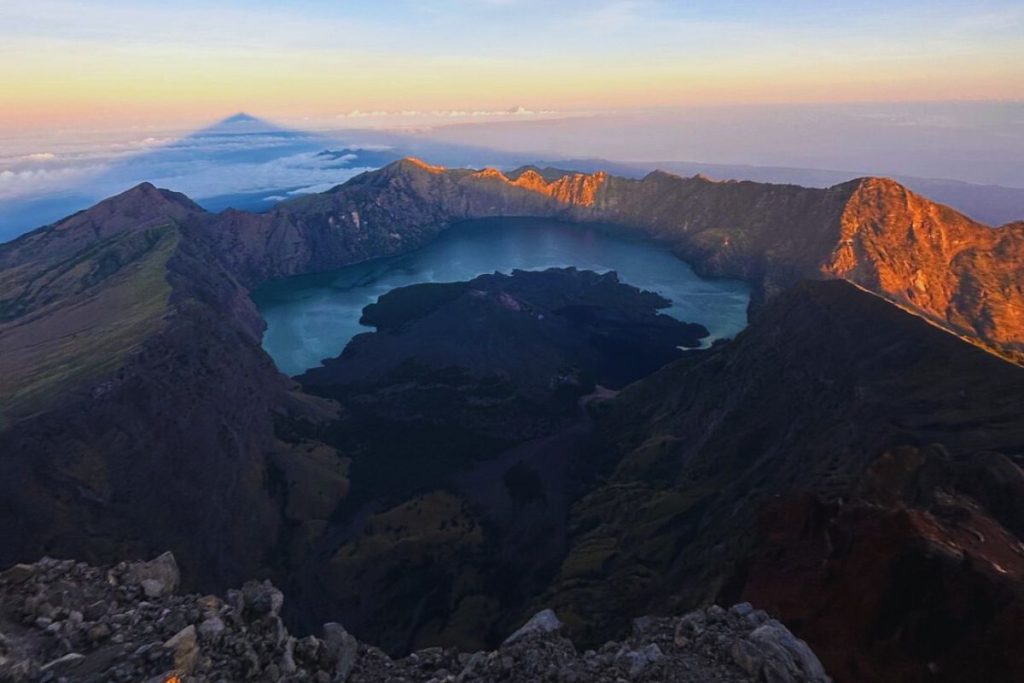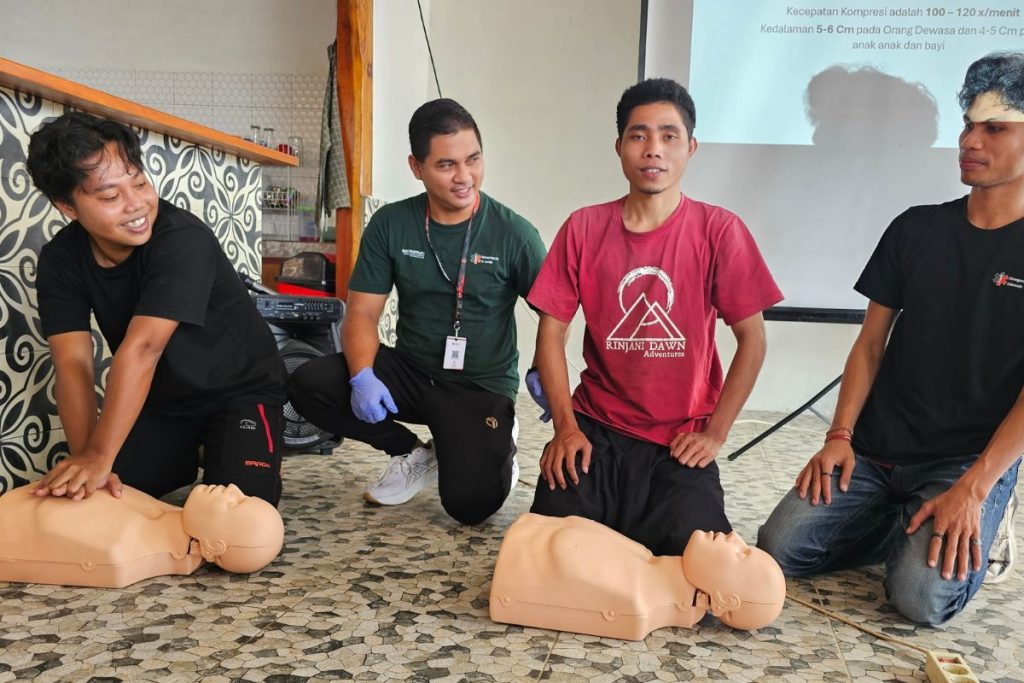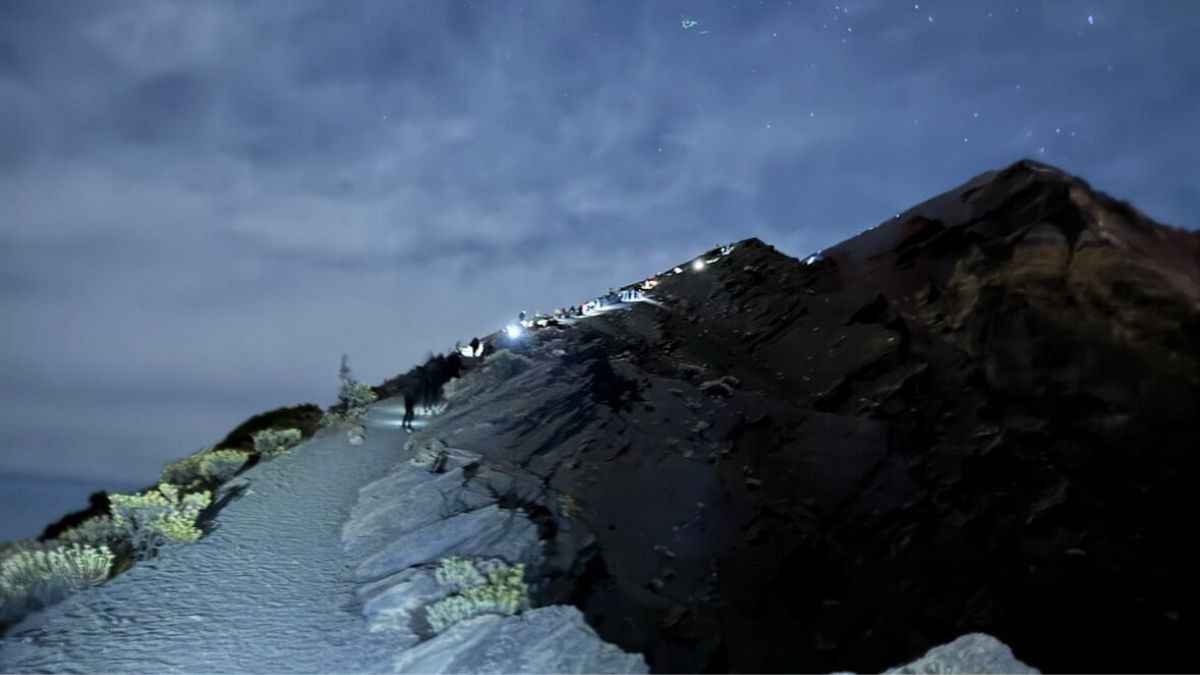- Tours
- Secret Lombok: 6 Day Wilderness Package
- 2 Day / 1 Night Mt Rinjani Summit Trek
- 3 Day / 2 Night Mount Rinjani Summit Trek
- 3 Day / 2 Night Mount Rinjani Torean Trek
- 4 Day / 3 Night Mount Rinjani Trekking Package
- 2 Day / 1 Night Senaru Crater Rim Trek
- Mangku Sakti Waterfall Day-Trip
- Gili Islands Snorkel Adventure
- Secret Gilis Snorkel & Camping Adventure
- Senaru Waterfall Tour; Sendang Gile & Tiu Kelep Waterfall
- Senaru Sightseeing & Camping Adventure
- Pergasingan Hill Camping Adventure
- Pergasingan Hill Scenic Day Trip
- Lombok Explorer
- Waterfalls to Wilderness Lombok Tour
- Benang Stokel & Benang Kelambu Waterfall Experience
- About
- Guides
- Reviews
- Contact Us

Climbing Rinjani Safely: What Our Guides Want You to Know
August 5, 2025 / Mount Rinjani, Lombok Island
Categories:
Written by the Rinjani Dawn Adventures Guide Team
Climbing Mount Rinjani safely means understanding the mountain, preparing well, and choosing the right guides. Climbing Mount Rinjani is a real adventure — and it’s a bit more than your average mountain hike. It’s high, it’s steep, and it’s full of surprises (both good and challenging). As guides who spend most of our lives on this mountain, we’ve seen it all – from golden summit mornings to twisted ankles and the occasional forgotten rain jacket.
This post isn’t here to worry you – it’s here to help. We want to share what we’ve learned over the years, and explain the safety systems we use at Rinjani Dawn Adventures to make sure every trek is as safe, smooth, and rewarding as possible.
Why Rinjani Isn’t Just Another Volcano Trek

With its sweeping crater views and dramatic summit ridge, Rinjani looks like something out of a movie — but it comes with real risks:
- Loose volcanic scree (especially on summit day)
- Long, steep descents into the crater lake
- Cold nights above 2,600m
- Thin air at 3,726m
- Sudden weather shifts
“Rinjani isn’t dangerous if you respect it, but problems usually happen when people arrive unprepared. They don’t train, they underestimate the terrain, or they forget key gear. As guides, we’re here to support you, but good decisions start before you reach the trail.”
— Saefudin Zohri, Operations Manager, Rinjani Dawn Adventures
Our Safety-First Approach at RDA

1. Training isn’t optional — it’s mandatory
Before each season, all RDA guides and porters go through first aid and emergency procedure training. We simulate scenarios like altitude sickness, joint injuries, and night evacuations. A lot of companies skip this completely — we don’t.
“Most of what we do is about prevention — watching footing, pacing the group, checking gear. But we also train every year to make sure we’re confident strapping sprains or soft-tissue injuries if they do happen. It’s part of being a responsible guide.”
— Sudi, RDA Guide
2. Preparation starts before you arrive — and we’re here to help
When you book a trek with us, we send out a detailed equipment and packing guide to help you prepare. It covers everything from headlamps and warm layers to what kind of boots are suitable for Rinjani’s steep, volcanic trails. It’s up to each guest to review this guide carefully and arrive properly equipped — safety starts with preparation.
That said, we understand that things can get overlooked. If you’ve forgotten something essential, or arrive with gear that’s not suitable for the mountain, we’ll do our best to loan you a replacement from our spares.
“A guest once arrived without a proper jacket – just a thin hoodie. We loaned her one of our insulated spares, and she said later there’s no way she could’ve handled the summit wind without it.”
— Hamdan, Logistics & Equipment Supervisor
3. More staff = safer treks

We run small group sizes with high staff-to-guest ratios. That means one guide can go ahead while another stays back if needed. For school groups and large parties, we carry extra radios and even a portable stretcher — just in case.
“For larger groups like school treks, we always carry a portable stretcher — just in case. Thankfully, we’ve never had to use it. One time a student twisted an ankle near the lake; we strapped it up, shared the load, and helped her out slowly. She still made it down smiling.”
— Lasa, Senior Guide
4. Summit or not — your call
Not everyone feels up to the summit, especially on Day 3 of the crater route. That’s fine. We do a summit briefing the night before, and support whatever decision you make — even if that means watching the sunrise from camp with coffee instead.
“I’ve seen guests in tears at the crater rim — not because they didn’t summit, but because the view was more than they imagined. Reaching the top is optional. Feeling safe and enjoying the journey is what really matters.”
— Hero, Senior Guide
5. Emergency Preparedness and Communication

At Rinjani Dawn Adventures, safety isn’t just something we talk about, it’s something we train for.
In 2024, our entire team participated in certified in-house training conducted by the North Lombok Regency Fire and Rescue Department. The training covered essential first aid practices, soft-tissue injury management, and basic fire response — all tailored to the unique challenges of guiding on Mount Rinjani.
During treks, we carry radios and mobile phones, and our team is trained to recognize the locations where signal is most reliable on the mountain. We maintain clear emergency communication protocols, so if a guest needs to descend early or if we ever require external support, we know exactly what steps to take – calmly and efficiently.
We don’t rely on luck or assumptions. We rely on preparation, training, and clear systems – and that’s one of the key reasons we’ve never had a serious accident or needed outside rescue in over a decade of operations.
“We don’t rely on luck or magic. We rely on systems. That’s how we’ve never had a serious accident or needed external rescue.”
— Adi, Senior Guide
The Little Things That Keep Big Problems Off the Mountain

- Get a good night’s sleep before commencing a Rinjani trek – try to stay locally the night before.
- Break-in your boots prior to coming – it will minimise the risk of blisters.
- Most incidents are preventable – take your time!
- Stay hydrated & warm. You can lose concentration if dehydrated or cold.
- “Looking tough” is no match for listening to your body. Ask your guide for help, if needed.
- Good gear, proper sleep, and enough porters solve a lot of problems before they start
Thinking of Trekking Rinjani? A Few Tips from Us:
- Train beforehand — it’s a real hike, not a sightseeing walk
- Consider a 4D3N itinerary for better acclimatization
- Hire a personal porter if you’re unsure about carrying your pack
- Don’t chase the summit if it’s not your day – the crater rim is still magic
Safety Starts with the Right Information
The best safety systems start before you ever set foot on the trail. Knowing what to expect — from trail difficulty to park rules — is essential to making smart decisions on the mountain.
👉 Check out the Mount Rinjani National Park website for official guidance, hiking regulations, and updates.
Final Word from the Team
We guide Rinjani because we love it — and because we want you to love it too. But loving this mountain means treating it with respect, preparing properly, and choosing a team that knows what they’re doing.
If you’re thinking about trekking Rinjani, we’re happy to talk — no pressure, just honest advice from people who’ve been up and down this trail more times than we can count.
Stay safe. Trek smart. And we’ll see you at the crater.
— The Rinjani Dawn Adventures Guide Team
Want to Dive Deeper into Rinjani Safety?
This post offers a glimpse into how we approach safety on the mountain — but if you’d like a more detailed breakdown of real risks, recent incidents, emergency services on Lombok, and what sets Rinjani Dawn Adventures apart from other operators, we’ve put together a dedicated resource for you.
👉 Explore our full Mount Rinjani Safety Guide here — it’s the most comprehensive safety page you’ll find for climbing Indonesia’s second-highest volcano.
Whether you’re planning a private trek, a school group, or your first high-altitude adventure, it’s a great place to get clear, honest advice.
Mount Rinjani Safety FAQ’s
What’s the most common issue you see on the Rinjani trail?
Soft-tissue injuries like sprained ankles or sore knees — usually from descending too fast or wearing the wrong footwear. That’s why we strongly recommend proper boots and trekking poles. We focus a lot on prevention, but our guides are also trained to strap injuries and support safe descents when needed.
Is it possible to get help if something goes wrong on Mount Rinjani?
Yes – we carry radios and mobile phones, and we know which parts of the mountain have reliable signal. While there’s no on-demand helicopter rescue, we have step-by-step systems in place to respond calmly and get guests the help they need. For larger groups, we even carry a portable stretcher, just in case.
What kind of training do your guides have?
All of our guides complete annual first aid and fire safety training, most recently in March 2025. This includes injury response, evacuation protocols, and mountain-specific scenarios. It’s one of the reasons we’ve never had a serious incident or needed outside rescue.
What happens if I feel sick from the altitude?
Mild symptoms of acute mountain sickness (AMS) — like headaches, nausea, or shortness of breath — are fairly common above 3,000 metres. Most of the time, these symptoms are manageable and improve naturally as your body adjusts or as you descend.
We don’t carry bottled oxygen — it’s not standard practice for Rinjani, and it can create a false sense of security. Instead, our focus is on prevention and early response: setting the right pace, encouraging hydration, and recognising symptoms early. If you’re not feeling well, we’ll descend with you to a lower elevation — and in most cases, guests feel much better within an hour or two of going down.
Your safety comes first, and our guides are trained to monitor for altitude-related issues and make calm, confident decisions if symptoms appear.
How can I prepare before arriving?
As soon as you book with us, we’ll send you a detailed equipment and preparation guide to help you get ready. You’re responsible for bringing the right gear, but if you forget something essential, we’ll do our best to loan spares before departure. Being well-prepared is one of the most important parts of a safe and successful trek.
Should I carry my own first aid kit?
Yes, absolutely. Every trekker should bring a small personal first aid kit — not just for emergencies, but for the small issues that can ruin a good trek if left untreated.
Your kit should include:
Any personal medications you require
Anti-inflammatories (like ibuprofen) and paracetamol
Anti-diarrheal medication (such as loperamide)
Plasters for blisters, plus blister tape or sports tape
A few antiseptic wipes and rehydration salts can also be helpful
Our guides carry a basic emergency kit for the group, but it’s not designed to replace your own essentials — especially for things like headaches, sore muscles, or mild stomach upsets. A well-prepped personal kit goes a long way in keeping you comfortable and self-reliant on the trail.
Popular Posts:
Newsletter
Sign up today and get all the latest news from Rinjani Dawn Adventures














